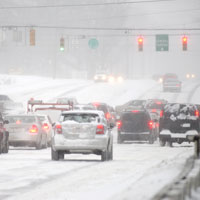It is wintertime in Alberta, with frigid temperatures, bone-chilling winds, and driving snow. It’s easy to forget how dangerous the roads can be here at this time of year, especially when the last few winters have been so unseasonably warm and dry. Here are our seven tips for avoiding a serious car accident in Alberta this winter.
When the mercury plummets, it’s tempting to just stay inside, but Albertans know that’s not an option; if we never went outside when the temperature dipped below zero we would be housebound for 6 months of the year. Whether it’s in Calgary or Edmonton, along the QE2, in the mountains, or on the prairies, Albertans have to be on the move no matter the conditions. Unfortunately, bad winters lead to bad car accidents. But with some precautions and preparations, you can avoid a fender-bender, a trip to the ditch, or worse.
- Get some winter tires. OK, we’ll admit that this seems obvious, but we had to mention it. Yes, winter tires can be expensive, but they are worth it for the safety of you and your family. If winter tires are beyond your budget consider trading in your all-seasons, which really are not for all seasons, for all-weather tires. Alberta often sees temperatures well below 7C, when all-season tires typically lose traction. Kal Tire provides a simple, handy guide to the differences
- Don’t follow too closely. This is another obvious one, but easy to follow and very effective. Leave at least a 3-carlength gap at speeds below 50 km/h and a 6-carlength gap at speeds above 50 km/h. Because this is Alberta, someone is likely to pull into that gap no matter what the conditions are, but you can always back off again when they do.
- Follow the “Fall 20 Below Zero Rule”. This is an easy one, also known as “slowing down.” When the snow falls and temperature drops below zero, drop your speed by 20 km/h. When the snow falls and the temperature is near freezing, it may melt at first but then refreeze, making roads very slippery, especially at intersections. When the snow falls and the temperature is even colder, the flakes can act like wax on a shuffleboard table, making roads even more slippery.
- Don’t try to make it. That left turn you make every time, without a problem on dry roads? You might not make it on snow and ice. Whatever the traffic manoeuvre, you’re going to need more time, space, and traction to make it in an Alberta winter.
- Look for traction. Speaking of traction, sometimes you might need to make an emergency stop, or even accelerate quickly to avoid a collision. In those cases, you can often find traction and it isn’t in the well-worn ruts of the road. The best place to find it is in the more loosely packed snow outside of the ruts, which gives your tires something to grip on to.
- Step away from the vehicle. If your car breaks down at the side of the road, or you slide into the ditch, get far away from it if you can. The same road and weather conditions that put you there could easily cause another driver to follow, and you don’t want to be in, or near your car if a vehicle careens into it. Get away, and get somewhere safe and warm if at all possible.
- Ignore your Alberta Good Samaritan instincts. We know this is the hardest one, but sometimes our Alberta politeness can actually make things worse when the weather is bad. That pedestrian at the corner that you spotted at the last minute? Don’t slam on your brakes to stop for her – you might be able to stop but the people behind you might not be so fortunate. That stranded motorist at the side of the road? We know that as an Albertan you feel the need to stop, get out of your car and help, but in a blizzard or icy conditions, you may be adding to the hazard and may be putting yourself in a life-threatening situation. If at all possible, leave it to emergency crews, fire, and police to help.


